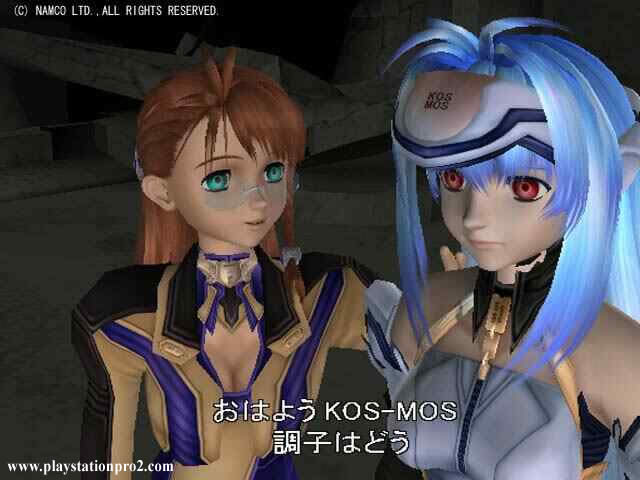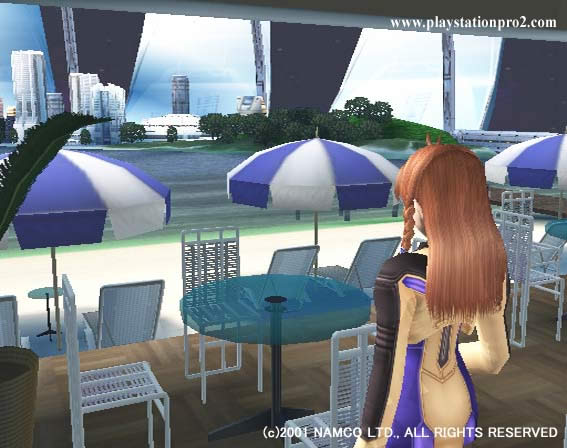


|
Developer: Monolith Soft
Publisher:
Genre:
# of Players:
Memory Card:
Rating:
Website: |
Xenosaga: Episode I
By: Matt Chin on March 23, 2003
I consider Xenogears to be one of my most favorite games of all time, so I was naturally looking forward to Xenosaga: Episode I. Both games are not directly linked, but with Tetsuya Takahashi heading up the "Xeno" project again, I expected the same masterful storytelling that was found in Xenogears to also appear in Xenosaga. Fortunately, my assumptions were correct, as Xenosaga easily offers the most engrossing storyline in any RPG to date.
The first chapter in the Xenosaga series starts off in the early 21st century where a strange artifact has been found in Kenya, Africa. This artifact is called the Zohar and the people who discovered it believe that it has existed since the beginning of time. The game eventually fast forwards to 4,000 years into the future, where the purpose of the Zohar is still a mystery. During this time, humans have decided to abandoned Earth in favor of space travel. Instead of worrying about disease and famine, humanities' greatest threat is an alien race called the Gnosis. As you can tell, Xenosaga has a sci-fi theme to it, which I find extremely refreshing after playing all these RPGs that mostly revolve around a medieval/fantasy theme.
The plot is easy to follow in the beginning, but as it unfolds, the sheer complexity of it becomes mind-boggling. In fact, the game makes a habit of bombarding the player with made-up terms, names, and theories that the developers purposely added a database in one of the menus so that you can look up unfamiliar words. A lot of things in Xenosaga are surrounded in mystery and once the fog finally starts to diminish the game concludes -- leaving many questions open for the next installment. This approach might turn some people off. However, I often found myself actually looking forward to the next batch of cut-scene because I was eager to see if the game was going to reveal something new.
That brings me to another potential flaw in Xenosaga -- the lengthy cut-scenes. Many people will argue that Xenosaga more resembles a movie rather than a video game due to many non-playable scenes reaching up to 15, 20 or even 30 minutes in length. As I stated numerous times already, the story in Xenosaga is so interesting that I honestly never found any of the cut-scenes to be overbearing. They are presented in real-time with a very cinematic style that really captures your attention. The voice acting adds to the experience as well, but more on that later.
When you are not watching cut-scenes, you are most likely exploring towns or dungeons. Traveling around towns and such is pretty straightforward. You can talk to residents and workers (who often say different things each time you speak to them in a row), bust open objects to find hidden items, buy/sell stuff or basically just fool around. When you are ready to move on, you simply need to talk to a certain person. Typical RPG stuff except for the fact that you can receive, reply, and download e-mail attachments within the game world. Pretty cool stuff.
As for the dungeons, they are essentially missions. You simply progress through the dungeons until you reach the end boss (some of them are actually challenging). Along the way, you'll need to solve simple puzzles, fight enemies, and collect keys or hit switches. I do admit that the dungeons can get quite boring (like in most other RPGs), but some new elements have been thrown in to give Xenosaga an edge over the competition. For example, you can see every single enemy on the screen, so you can avoid battles just like in Metal Gear Solid with the assistance of an onscreen radar. Also, to add some strategy, you can use traps to weaken opponents just before you head into battle with them. Even though they are weaken, you still earn the same amount of experience points.
In addition, the unique turn-based battle system provides a lot of depth to the game. For instance, you can unleash sweet looking combos and tech attacks. And after each successful battle, you will earn experience points, tech points, ether (magic) points, and skill points. When characters level up, their attributes go up about one point, but you can use tech points to improve their attributes anyway you see fit. You can pump your points into more HP or into a higher 'ether defense' rating. The choice is up to you. Ether points allow you to earn new spells and skill points are for acquiring new skills.
Mecha fans may find it disappointing that fighting in gears (or A.G.W.S. as it is called in the Xenosaga universe) is not as important in Xenosaga as it was in Xenogears. In Xenogears, you were forced to fight in gears during certain portions of the game. In Xenosaga, you can jump in and out of your A.G.W.S. any time you wish, but it isn't really necessary until the last 20 or 30 percent of the game. Personally, this didn't bother me, but it is still worth mentioning.
Another one of Xenosaga's strong points are its graphics. The character, battleship, and mech designs look incredible in the cut-scenes. Outside the cut-scenes, they do not look as good which is understandable because the view is pulled out further. The animations are usually fluid and convincing as well.
The only problem I have from a visual standpoint are the facial expressions. During the end of the game, the main character becomes very upset but the expression on her face does not match the anxiety in her voice. Also, the mouths are not synchronized well with the voices, but once again, this is understandable since the game originates in Japan.
I am a fan of Yasunori Mitsuda's music in Chrono Cross and Xenogears, but his soundtrack in Xenosaga appears to be lacking. For example, bosses and regular enemies share the same battle music and when exploring some towns and dungeons, there will be no music at all! Some areas in Xenogears didn't have music either for some reason, but the songs that were present are unforgettable. Sadly, I can't say the same for Xenosaga. Needless to say, I won't be buying the official Xenosaga soundtrack CD any time soon.
On the good side, Namco did an excellent job on the voice acting. The translation from Japanese to English worked out well despite some rare pieces of awkward dialogue.
All in all, it took me about 40 hours to complete Xenosaga and I loved every minute of it (well, except for the ending credits). I spent a couple of those hours messing around with the four available mini-games, so it is possible to finish the game in about 35 hours -- assuming you omit the side-quests as well. If you are the type of person who has to collect everything in an RPG, then I'd estimate about 45-50 hours in the entire package. Maybe a little more.
Xenosaga: Episode 1 starts off slow, but I am certain that if you are willing to wade through the initial group of cinemas, then you should enjoy the entire game. Definitely worth a purchase for most people.
Overall Score: 9.4 (Excellent)
| Best Features (+) | Worst Features (-) |
| The Battle System | "So-So" Music |
| No Random Encounters | Puzzles are too easy |
| Excellent Story line | It ends |
| Fun minigames | Having to wait for Episode II |
Additional Media
Screenshot 4|
Screenshot 5|
Screenshot 6|
Screenshot 7|
Screenshot 8|
Screenshot 9|
Screenshot 10
© Copyright 2003 PlayStation Pro 2


